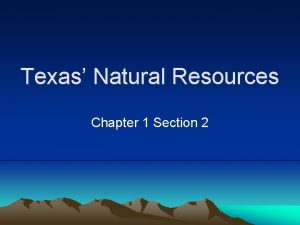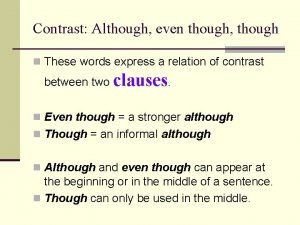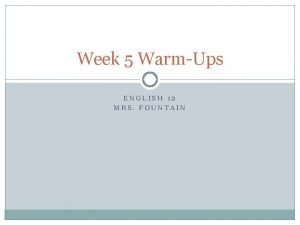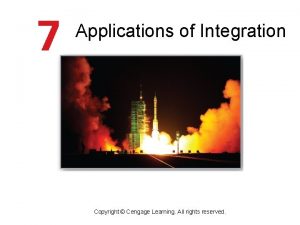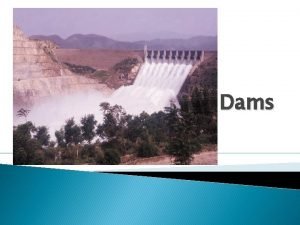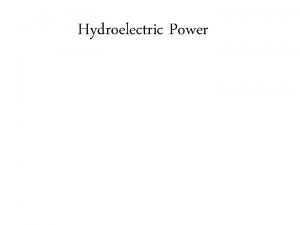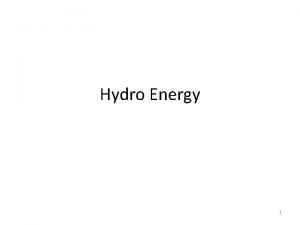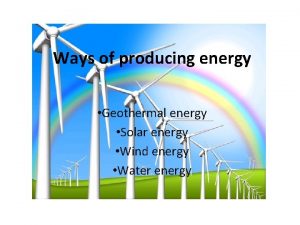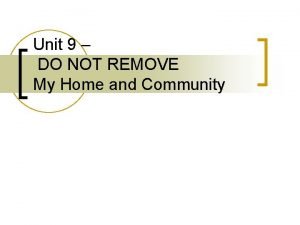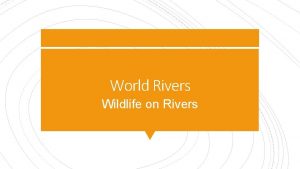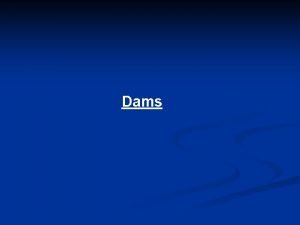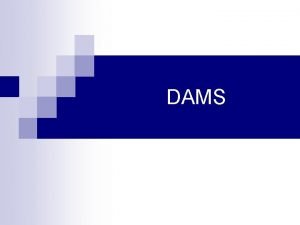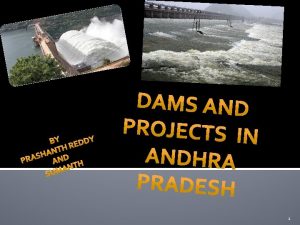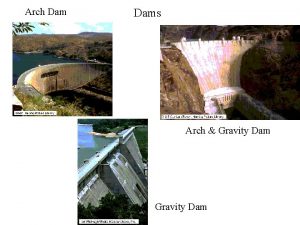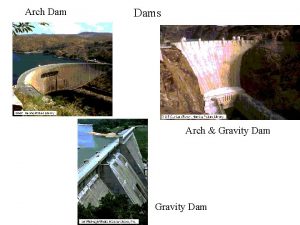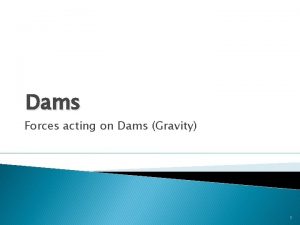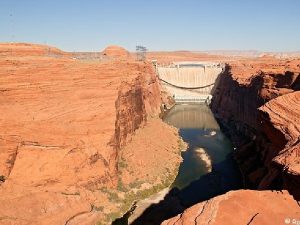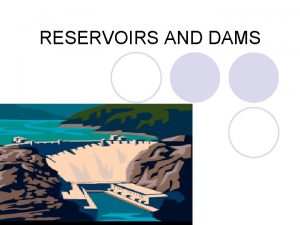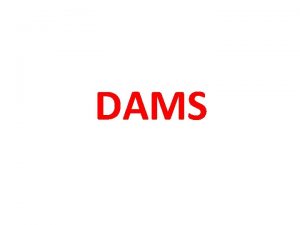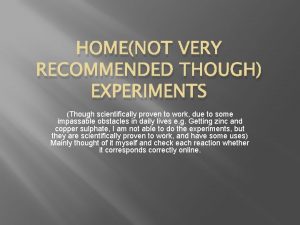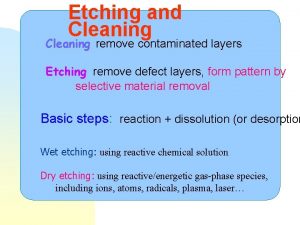Should We Remove Dams From Rivers Even Though



























- Slides: 27

Should We Remove Dams From Rivers, Even Though Doing So Reduces The Opportunity For Hydropower Production? EGY/EES/BIO 105: Energy Of Our World Professor Dr. K. Kelmow FALL 2016 Project Group: Michael Condrad Cassidy Orrell James Zijac Jeremey Tomaine

TOPICS OF PRESENTATION ● The Personal Impacts & The Public’s Opinion on Dams In Riverbeds…………………………. By James Zijac ● The Technical Standpoints of Hydroelectric Power As An Energy Source……………. … By Michael Condrad ● The Legal Points of Dams Through Natural Rivers………………………………………………. . …. ……………. By Cassidy Orrell ● The Financial Impacts Of Producing Hydropower From Dams in Riverbeds……………. . . By Jeremey Tomaine

Personal Impacts Dams directly impact millions of people a year. Provide power and drinking water. Dams are very important hydropower producers. Full cities powered by dams. Disrupt ecosystems. Fish breeding inhibited, entire system flow is disturbed.

Why The Public Opinion Matters Ø Public chooses elected officials based on their views on projects like dam removal. Ø If the public speaks loud enough on either side, change can happen.

The Technical Standpoints of Hydroelectric Power As An Energy Source By Michael Condrad Ø From Flowing Water To The Electricity That Powers Our Homes? How Does This Process work? Ø A Breakdown of The Modern Dam. Ø The interworking's of The Turbine & Generator. Ø The Transmission & Transformation of Produced Electric Power. Reference Link: http: //www. ws-corp. com/wsc 08/wsc 14/default. asp? Page. ID= 13

4 Main Parts of a Hydroelectric Plant: 1. 2. 3. 4. The Dam The Turbine The Generator The Transmission Lines Reference Link: http: //water. usgs. gov/edu/wuhy. html

THE MODERN DAM The Glen Canyon Dam – Colorado River Reference Link: http: //www. earthmagazine. org/article/releasing-flood-controversy-colorado-river

THE TURBINE / GENERATOR Reference Link: https: //upload. wikimedia. org/wikipedia/commons/0/09/Water_turbine_%28 en_2%29. svg

THE TRANSMISSION LINES & TRANSFORMERS Reference Link: http: //wastetoenergysystems. com/wp-content/uploads/2016/01/power- lines. jpg

The Legality of Constructing Or Removing A Dam As presented by: Cassidy Orrell (Criminology Major) Wapping Road dam before removal Wapping Road dam after removal Dam being torn down

Department of Environmental Protection

The DEP ensures that the public is involved when making decisions that affect the community! Office of Environmental Justice The OEJ is committed to encouraging communication between DEP and communities in Pennsylvania. By building environmentally aware, healthy, and knowledgeable communities, the OEJ can work towards the removal of barriers; stimulate sustainable and environmentally friendly development; and implement policies, regulations, and legislation that provide equal protection to environmental justice communities throughout the Commonwealth of Pennsylvania. The Office of Environmental Justice was established as a point of contact for Pennsylvania residents in low income areas and areas with a higher number of minorities. Its primary goal is to increase communities' environmental awareness and involvement in the DEP permitting process. Environmental Quality Board(EQB) Public participation is encouraged during the regulatory process. Concerned citizens can submit written comments on a proposed regulation using our online comment system or by written mail. Citizens Advisory Council It is the mission of the Citizens Advisory Council to strive to ensure that all people of the Commonwealth enjoy the benefits included in Article I, Section 27 of the Pennsylvania Constitution. The Council strives to represent all people of the Commonwealth and endeavors to bring a collective view of the public interest in environmental protection and natural resources, forged from the Council's own diversity of personal experiences and perspectives.

Pennsylvania Constitution (Article I, Section 27) “The people have a right to clean air, pure water, and to the preservation of the natural, scenic, historic and esthetic values of the environment. Pennsylvania's public natural resources are the common property of all of the people, including generations yet to come. As trustees of these resources, the Commonwealth shall conserve and maintain them for the benefit of all the people. ”

Dam Permit A Dam Permit is required from DEP before any person may construct, operate, maintain, modify, enlarge or abandon a dam that meets any one of the 5 criteria, as stated on the instructions page for a Dam Permit Application: ● 1. The dam is located across a watercourse and the contributory drainage area to the dam exceeds 100 acres. ● 2. The dam is located across a watercourse and the maximum depth of water, measured from the upstream toe of the dam to the top of the dam at maximum storage elevation, is greater than 15 feet. ● 3. The dam is located across a watercourse and the impounding capacity (storage volume) at maximum storage elevation is greater than 50 acre-feet.

Dam Permit ● 4. The dam stores water, is not located on a watercourse, and has no contributory drainage, but the maximum depth exceeds 15 feet and the maximum storage volume exceeds 50 acre-feet. ● 5. The dam is used for storage of fluids or semi-fluids other than water, the escape of which may result in air, water, or land pollution or in danger to persons or property.



SECTION E. APPLICATION COMPLETENESS CHECKLIST ● 1. Permit application properly signed, sealed and witnessed ● 2. Completed Permit Application and General Information Form ● 3. Application Fee (attach completed worksheet 3150 -PM-BWEW 0553) ● 4. Copies and proof of receipt - Act 14 notification ● 5. Cultural Resource Notice ● 6. Completed PNDI Form (see instructions) ● 7. Site Plan (including cross sections and location maps) ● 8. Project description narrative ● 9. Color photographs with map showing locations taken ● 10. Erosion and Sedimentation Control Plan and approval letter (see instructions) ● 11. Hydrologic and hydraulic analysis ● 12. Stormwater Management Analysis w/consistency letter ● 13. Floodplain Management Analysis w/consistency letter ● 14. Risk Assessment ● 15. Environmental Assessment form ● 16. Alternatives Analysis ● 17. Mitigation plan ● 18. Proof of title or adequate flowage easements (see instructions) ● 19. Data on site and construction materials ● 20. Design drawings, reports and technical construction specifications ● 21. Emergency Action Plan (May submit after approval of breach analysis) ● 22. Instrument performance monitoring plan ● 23. Proof of financial responsibility (see instructions) ● 24. Data on chemical content, viscosity and other characteristics ● 25. Operation and Maintenance Manual ● 26. Copies of most recent inspection reports ● 27. Professional engineer’s embossed seal and certification ● 28. Proposed time for commencement and anticipated start of construction

What is an Emergency Action Plan? ● An Emergency Action Plan (EAP) is a formal document that describes procedures to minimize the risk of loss of life and property damage when potential emergency conditions threaten a Hazard Potential Category 1, 2 or 3 dam. ● An emergency at a dam is any condition that endangers the structural integrity of the dam which might result in the dam’s failure, thus unexpectedly flooding downstream areas. Such threatening conditions demand immediate action on the part of the owner. ● Those actions are described beforehand in an approved EAP. ● Every EAP is tailored to site specific conditions.

What are Hazard Potential Categories 1 -3? ● Category 1 Hazard potential describes a “high-hazard” dam that could cause substantial loss of life, excessive economic loss, or substantial public inconvenience by its sudden failure. ● A Category 2, “high hazard” potential dam is one that, in the event of operational or structural failure, could result in the loss of a few lives. ● Failure of a Category 3, “non-high-hazard” dam, would not likely endanger human life, but could result in appreciable property damage or short duration public inconvenience. Public inconvenience could result from flooding of important roads, washout of a bridge, destruction or disruption of public utilities, etc. Why Must the Dam Have an EAP? ● An EAP is needed for three reasons: ● 1. To plan the coordination of necessary actions and resources by the dam owner and the responsible local, state and federal emergency organizations. ● 2. To provide for timely notification or warning for evacuation in the event of an emergency situation at the dam. ● 3. It’s the law! Requirements for the design, construction, operation, maintenance and inspection of dams are intended to prevent dam failures. Despite these efforts, abnormal conditions sometimes develop that could threaten a dam’s safety. Therefore, Pennsylvania’s Dam Safety and Encroachments Act (Act 325 and Act 70) mandates EAPs for Hazard Potential Category 1, 2 and 3 dams.

Legality : Section Wrap-up ● So as you can see, a lot goes in to constructing and demolishing dams. It is quite a process! ● There is a whole Government Entity that regulates, and oversees environmental issues and tasks to ensure that humanity and our environmental surroundings and ecosystems live in harmony and safety!

Dam Financing ● Dam financing is often the weakest link for a project ● Public and private sectors often form partnerships to pay ● Traditionally, The World Bank Group ● In recent years, Chinese financial institutions have began financing ● Climate finances, e. g. Green Climate Fund

Positive Economic Benefits of Dams ● Increased agriculture ● positive trickle down effects to local farmers ● Stable source of drinking water ● Increased navigability ● increase the exports and imports ● Boulder City, Nevada

Boulder City, Nevada

Lake Wallenpaupack Dam, PA

Negative Economic Benefits of Dams ● Unintentional Flooding ● Migratory Fish become displaced ● Trap Sediment ● People are at the mercy of Power Companies ● Riverbed Deepening

Thank you! Any Questions?
 Although but despite however
Although but despite however Why are some rivers in texas called “wrong way” rivers?
Why are some rivers in texas called “wrong way” rivers? Module 19 visual organization and interpretation
Module 19 visual organization and interpretation Even though i walk through the valley
Even though i walk through the valley Is even though a contrast word
Is even though a contrast word Though we walk in the flesh
Though we walk in the flesh Even though beowulf was originally dgp
Even though beowulf was originally dgp Even though i walk
Even though i walk Though satan should buffet
Though satan should buffet Language definition
Language definition Regular expression of even even language
Regular expression of even even language Dams roma tre
Dams roma tre Fdr election map
Fdr election map Uplift force on dam
Uplift force on dam Caravaggio specchio
Caravaggio specchio Tasmanian dam case
Tasmanian dam case Forces acting on earthen dam
Forces acting on earthen dam Vertical gates in dams
Vertical gates in dams Overflow and non overflow dams
Overflow and non overflow dams Head race and tail race
Head race and tail race Nick dams
Nick dams Purdom power plant
Purdom power plant Types of dams
Types of dams Uses of dams
Uses of dams Advantages and disadvantages of dams
Advantages and disadvantages of dams One should not lose heart even when we faced with
One should not lose heart even when we faced with Spatial visualization asl
Spatial visualization asl Remove background from image
Remove background from image

